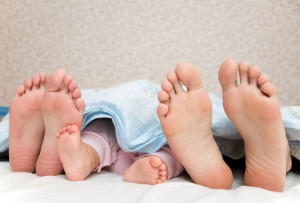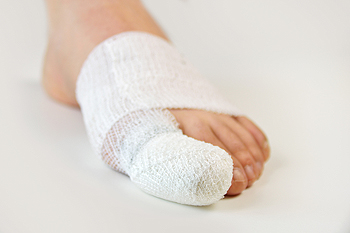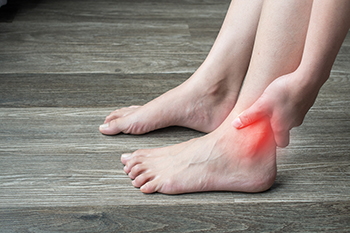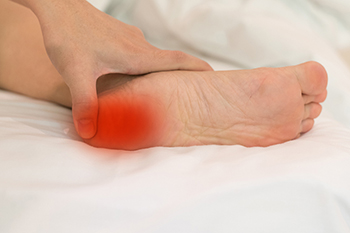Connect With Us
Blog
Items filtered by date: August 2022
Reminder: When Was the Last Time...?
Juvenile Plantar Dermatosis

Juvenile plantar dermatosis is a common and chronic dry skin condition of the feet that usually affects pre-adolescent children between the ages of three and 14 years. It is also known as atopic winter feet and forefoot dermatitis. This condition affects boys slightly more often than girls. It is rarely seen in adults but can persist into adulthood. Juvenile plantar dermatosis can be caused by repetitive frictional movements, the occlusive effect of wearing covered footwear (particularly synthetic shoes), excessive sweating, genetic sensitivities, or warm or cool climate changes. This problem is usually visible on the weight-bearing areas of the soles, ball of the big toes, and forefoot of the foot with itchy, sore, shiny, red skin that has a glazed appearance and a loss of the epidermal ridge pattern. Typically, both feet are affected. The most common complication of juvenile plantar dermatosis is painful cracks and fissures, which may become infected. This affliction is sometimes confused with other skin conditions, such as atopic eczema, plantar psoriasis, or tinea pedis. Wearing well-fitting leather shoes, two or more pairs of cotton and wool socks, and changing socks regularly will help reduce friction. Moisturizing the feet will help prevent dry skin. Resting the feet to allow any fissures to heal will help as well. If your child is experiencing problems with the skin of their feet, consult with a podiatrist who can diagnose any conditions and provide options for treatment.
Making sure that your children maintain good foot health is very important as they grow. If you have any questions, contact one of our podiatrists of Boca Raton Podiatry . Our doctors can provide the care you need to keep you pain-free and on your feet.
Keeping Children's Feet Healthy
Having healthy feet during childhood can help prevent medical problems later in life, namely in the back and legs. As children grow, their feet require different types of care. Here are some things to consider...
Although babies do not walk yet, it is still very important to take care of their feet.
Avoid putting tight shoes or socks on his or her feet.
Allow the baby to stretch and kick his or her feet to feel comfortable.
As a toddler, kids are now on the move and begin to develop differently. At this age, toddlers are getting a feel for walking, so don’t be alarmed if your toddler is unsteady or ‘walks funny’.
As your child gets older, it is important to teach them how to take care of their feet.
Show them proper hygiene to prevent infections such as fungus.
Be watchful for any pain or injury.
Have all injuries checked by a doctor as soon as possible.
Comfortable, protective shoes should always be worn, especially at play.
If you have any questions please feel free to contact our office located in Boca Raton, FL . We offer the newest diagnostic and treatment technologies for all your foot and ankle needs.
What is Freiberg’s Disease?

Despite the fact that Freiberg’s disease is a rare foot condition, it can still be helpful to learn more about the affliction in case you or a loved one develops it. Generally speaking, an individual who suffers from Freiberg’s disease has a fractured base of the metatarsal bones, located on the ball of the feet. This primarily affects the second and third metatarsal bones. There are multiple potential causes of Freiberg’s disease. First, the disease can be caused by excessive weight-bearing activities—such as jumping and running—that put extra strain on the ball of the feet. This can essentially lead to sustained trauma over time, ultimately resulting in Freiberg’s disease. If you have Freiberg's disease, you might notice a sense of pain and discomfort around the affected area. It is also common for someone who suffers from this condition to experience swelling and bruising of some sort on and around the feet. Rare foot conditions certainly will not affect everyone. However, it is possible that you or someone you know could be affected. If you think that you could have Freiberg’s disease, reach out to a podiatrist who will be able to help you.
Some foot conditions may require additional professional care. If you have any concerns, contact one of our podiatrists of Boca Raton Podiatry . Our doctors can provide the care you need to keep you pain-free and on your feet.
Rare Foot Conditions
The majority of foot conditions are common and can be treated by a podiatrist. Standard diagnostic procedures are generally used to identify specific conditions and treatment can be rendered. A podiatrist also treats rare foot conditions which can be difficult to diagnose and may need extra attention and care.
There are many rare foot conditions that can affect children. Some of these can include:
- Freiberg’s disease
- Kohler’s disease
- Maffucci syndrome
Freiberg’s disease - This can be seen as a deterioration and flattening of a metatarsal bone that exists in the ball of the foot. It typically affects pre-teen and teenage girls, but can affect anyone at any age. Symptoms that can accompany this can be swelling, stiffness, and the patient may limp.
Kohler’s disease - This often targets the bone in the arch of the foot and affects younger boys. It can lead to an interruption of the blood supply which ultimately can lead to bone deterioration. The patient may limp or experience tenderness, swelling, and redness.
Maffucci syndrome - This affects the long bones in a child’s foot leading to the development of abnormal bone lesions. They are benign growths and typically develop in early childhood and the bones may be susceptible to breaking.
A podiatrist can properly diagnose and treat all types of rare foot conditions. If your child is affected by any of these symptoms or conditions, please don’t hesitate to call our office so the correct treatment method can begin.
If you have any questions please feel free to contact our office located in Boca Raton, FL . We offer the newest diagnostic tools and technology to treat your foot and ankle needs.
Broken Toe Treatment Options

Many people who have endured a broken toe often treat it by using the buddy taping method. This is done by taping the affected toe to the toe next to it, and is often an effective method in providing the stability that is necessary to completely heal the toe. A broken toe can occur from a heavy object falling on it, or if it is jammed into a piece of furniture. If the fracture is severe, there may be a bone that protrudes through the skin, and immediate medical attention is needed. Part of the recovery process is to stay off of the foot as much as possible, in addition to limiting daily activities. The toe will most likely be swollen and bruised, and it will be painful to walk without limping. Some patients opt to use a walking boot, and this can be helpful in relieving some of the pressure on the affected toe. Larger shoes may need to be purchased that can accommodate the broken toe, and a splint may need to be worn, depending upon which toe is affected. If you have broken your toe, please speak with a podiatrist who can guide you toward the treatment that is correct for you.
Broken toes may cause a lot of pain and should be treated as soon as possible. If you have any concerns about your feet, contact one of our podiatrists from Boca Raton Podiatry . Our doctors will treat your foot and ankle needs.
What Is a Broken Toe?
A broken toe occurs when one or more of the toe bones of the foot are broken after an injury. Injuries such as stubbing your toe or dropping a heavy object on it may cause a toe fracture.
Symptoms of a Broken Toe
- Swelling
- Pain (with/without wearing shoes)
- Stiffness
- Nail Injury
Although the injured toe should be monitored daily, it is especially important to have a podiatrist look at your toe if you have severe symptoms. Some of these symptoms include worsening or new pain that is not relieved with medication, sores, redness, or open wounds near the toe.
If you have any questions, please feel free to contact our office located in Boca Raton, FL . We offer the newest diagnostic and treatment technologies for all your foot care needs.
Why Is Your Ankle Feeling Wobbly and Painful?
 If you have suffered an ankle sprain that has not healed properly, and it has left your ankle ligaments overly loose, you are most likely experiencing ankle instability. A podiatrist will typically diagnose you with ankle instability if you are still experiencing weakness and laxity 6 months after an ankle sprain, or if you have suffered multiple ankle sprains. This is a common occurrence when the initial ankle sprain was not treated satisfactorily, which would have prevented it from healing properly. Ankle instability can also cause pain and tenderness, swelling and discomfort, and cause your ankle to repeatedly “give way.” Ankle instability that goes untreated may lead to chronic ankle instability, and even osteoarthritis in worst case scenarios. If you have had an ankle sprain in the past, and your ankle feels wobbly, weak, painful, or tender, there are treatments to help. It is suggested you start by having a podiatrist examine you and diagnose your condition.
If you have suffered an ankle sprain that has not healed properly, and it has left your ankle ligaments overly loose, you are most likely experiencing ankle instability. A podiatrist will typically diagnose you with ankle instability if you are still experiencing weakness and laxity 6 months after an ankle sprain, or if you have suffered multiple ankle sprains. This is a common occurrence when the initial ankle sprain was not treated satisfactorily, which would have prevented it from healing properly. Ankle instability can also cause pain and tenderness, swelling and discomfort, and cause your ankle to repeatedly “give way.” Ankle instability that goes untreated may lead to chronic ankle instability, and even osteoarthritis in worst case scenarios. If you have had an ankle sprain in the past, and your ankle feels wobbly, weak, painful, or tender, there are treatments to help. It is suggested you start by having a podiatrist examine you and diagnose your condition.
Ankle pain can have many different causes and the pain may potentially be serious. If you have ankle pain, consult with one of our podiatrists from Boca Raton Podiatry . Our doctors will assess your condition and provide you with quality foot and ankle treatment.
Ankle pain is any condition that causes pain in the ankle. Due to the fact that the ankle consists of tendons, muscles, bones, and ligaments, ankle pain can come from a number of different conditions.
Causes
The most common causes of ankle pain include:
- Types of arthritis (rheumatoid, osteoarthritis, and gout)
- Ankle sprains
- Broken ankles
- Achilles tendinitis
- Achilles tendon rupture
- Stress fractures
- Tarsal tunnel syndrome
- Plantar fasciitis
Symptoms
Symptoms of ankle injury vary based upon the condition. Pain may include general pain and discomfort, swelling, aching, redness, bruising, burning or stabbing sensations, and/or loss of sensation.
Diagnosis
Due to the wide variety of potential causes of ankle pain, podiatrists will utilize a number of different methods to properly diagnose ankle pain. This can include asking for personal and family medical histories and of any recent injuries. Further diagnosis may include sensation tests, a physical examination, and potentially x-rays or other imaging tests.
Treatment
Just as the range of causes varies widely, so do treatments. Some more common treatments are rest, ice packs, keeping pressure off the foot, orthotics and braces, medication for inflammation and pain, and surgery.
If you have any questions, please feel free to contact our office located in Boca Raton, FL . We offer the newest diagnostic and treatment technologies for all your foot care needs.
Discovering the Source of Your Heel Pain

Heel pain is a common affliction that podiatrists treat on a daily basis. They see many different forms of heel pain emanating from injuries to soft tissues and other structures, breaks in bones, and arthritis. Soft tissue inflammatory conditions that cause heel pain include plantar fasciitis (inflammation of the plantar fascia tissue on the sole of the foot), Achilles tendonitis (inflammation of the Achilles tendon at the back of the ankle that connects the calf muscles to the heel), ligament sprains and muscles strains near the heel, and bursitis (inflammation of the bursa sac between the heel and the Achilles tendon). A fractured heel can vary from a small crack to a full break in the bone, and cause a great deal of heel pain. There are also different forms of arthritis, such as ankylosing spondylitis and reactive arthritis, which can cause pain and tightness in the heel. To have your heel pain properly diagnosed and treated, make an appointment with a podiatrist who can help devise an effective treatment plan to address your specific condition.
Many people suffer from bouts of heel pain. For more information, contact one of our podiatrists of Boca Raton Podiatry . Our doctors can provide the care you need to keep you pain-free and on your feet.
Causes of Heel Pain
Heel pain is often associated with plantar fasciitis. The plantar fascia is a band of tissues that extends along the bottom of the foot. A rip or tear in this ligament can cause inflammation of the tissue.
Achilles tendonitis is another cause of heel pain. Inflammation of the Achilles tendon will cause pain from fractures and muscle tearing. Lack of flexibility is also another symptom.
Heel spurs are another cause of pain. When the tissues of the plantar fascia undergo a great deal of stress, it can lead to ligament separation from the heel bone, causing heel spurs.
Why Might Heel Pain Occur?
- Wearing ill-fitting shoes
- Wearing non-supportive shoes
- Weight change
- Excessive running
Treatments
Heel pain should be treated as soon as possible for immediate results. Keeping your feet in a stress-free environment will help. If you suffer from Achilles tendonitis or plantar fasciitis, applying ice will reduce the swelling. Stretching before an exercise like running will help the muscles. Using all these tips will help make heel pain a condition of the past.
If you have any questions please contact our office located in Boca Raton, FL . We offer the newest diagnostic and treatment technologies for all your foot and ankle needs.


